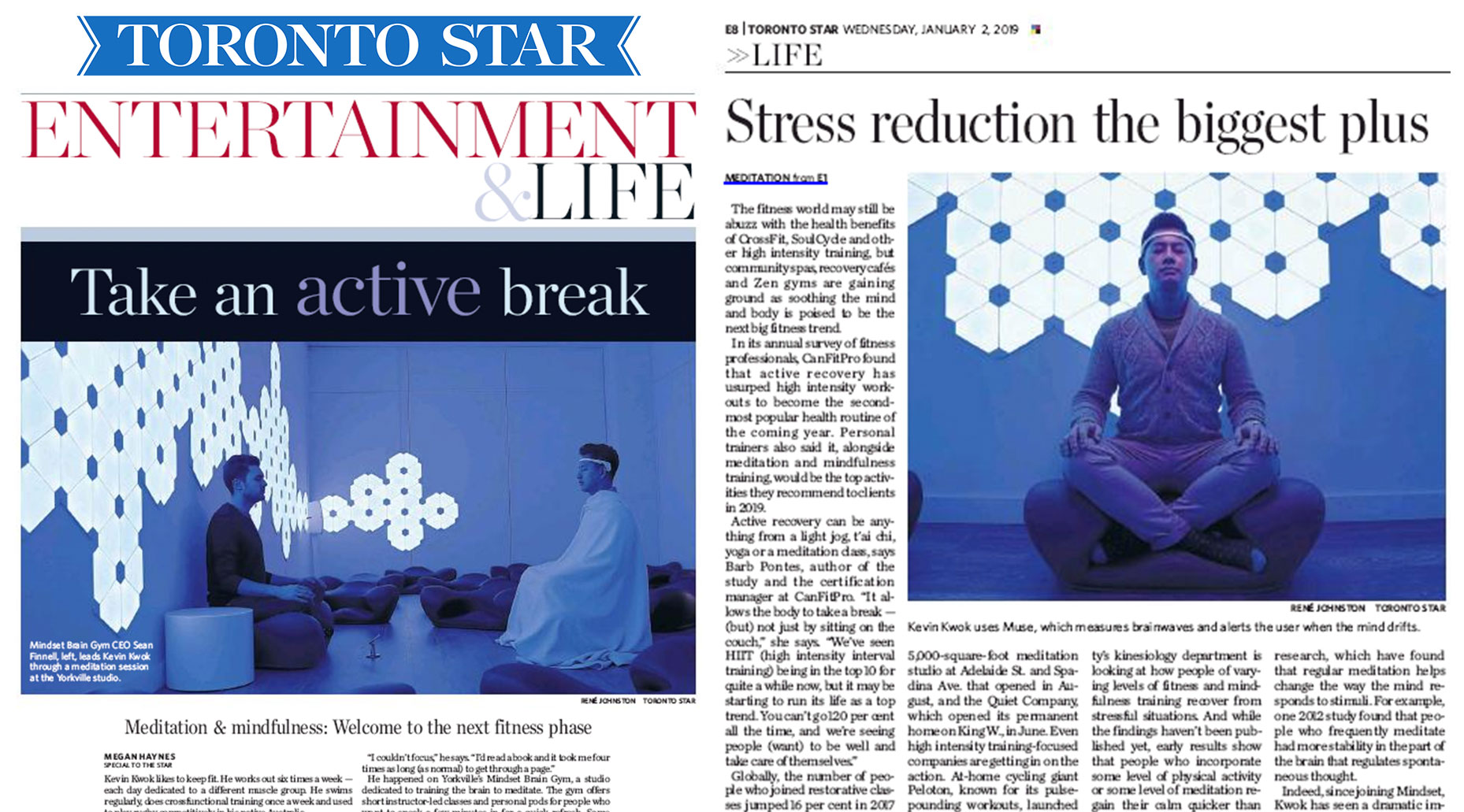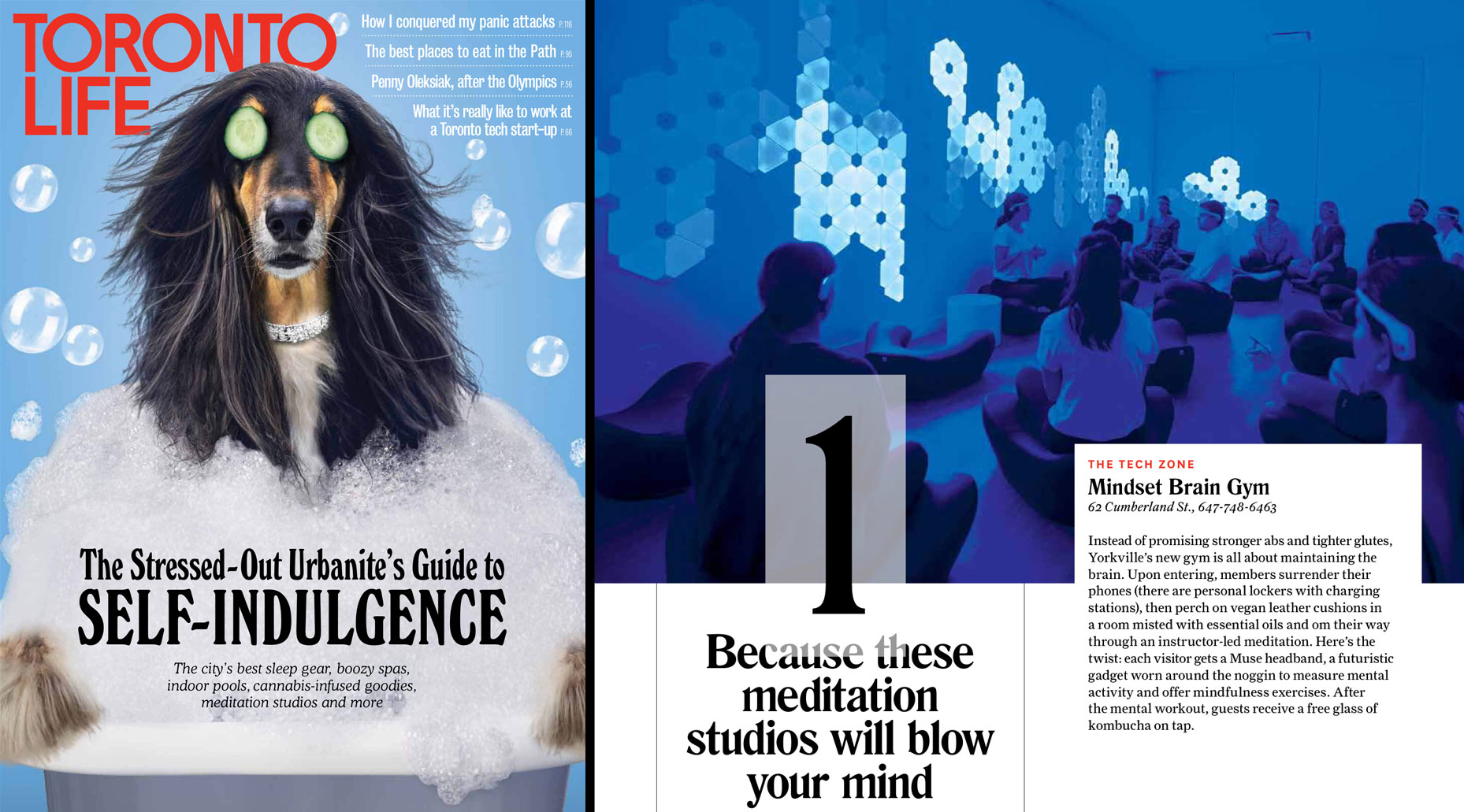I designed the first modern meditation & breathwork studio aimed at urban professionals.
Company
MINDSET brain gym
Role
Co-Founder & Chief Product Officer
Time Period
2018-20
To comply with any non-disclosure agreements, I have omitted and obfuscated confidential information in this case study. All information in this case study is my own and does not necessarily reflect the views of MINDSET brain gym.
BACKGROUND
Mindfulness was rapidly gaining mainstream awareness in the late 2010s, in large part driven by mobile apps like Headspace and Calm. Alongside these VC-backed companies already solidifying their digital dominance, brick-and-mortar meditation studios began to emerge in the NYC & LA markets, offering drop-in classes through the proven boutique fitness model.
PROBLEM
Nobody benefits more from a meditation practice than urban professionals. Many were curious about mindfulness, but remained skeptical or struggled to stick with the practice via an app. Despite this, the meditation studios introduced thus far weren't connecting with a mainstream professional audience – instead tailoring their offering towards those already deeply receptive.
MANDATE
I set out to design an experiential space and product offering that resonated with the unique needs and worldview of the urban professional: one that framed mindfulness through the lens of performance, supported by scientific credibility, technology, and design. Ultimately, if we could unlock product-market fit with this underserved demographic through a pilot studio in Toronto, we could scale our concept throughout the U.S. and Canada, and emerge as a dominant player.
RESULTS
Our go-to-market plan succeeded beyond expectations: at launch, we garnered exceptional press coverage and had no struggles with early client acquisition. We had successfully proven our unique positioning strategy resonated with urban professionals, and made our product offering easily approachable. However, it rapidly became clear we struggled with retention. Consumers were eager to try the concept, but didn't feel enough of an impact to justify continued attendance.
After a year of experimentation, I eventually found product-market fit with drop-in breathwork classes (which offered a more tangible, immediate impact better suited to the drop-in model) and multi-week mindfulness courses. I also recognized early potential in corporate offerings, successfully taking advantage through rapidly bringing a B2B2C product mix to market and securing contracts with top-tier employers including TD, BMO, PwC, McKinsey, Uber, and adidas.
Unfortunately, shortly after achieving consistent break-even operations, the pandemic halted our momentum. Given the economic impact of prolonged lockdowns, we made the prudent early call to liquidate the business.
BRICK-AND-MORTAR MEDITATION
WASN'T FOR EVERYONE
A growing trend was emerging in the United States: urban meditation studios that followed a similar business model to yoga and spin studios. Garnering top-tier press in the New York Times and Vogue, they offered many advantages over the ascendant apps: a sense of community, personalized live guidance from a highly-trained instructor, and a calming atmosphere to truly unwind from the busy city.
None existed yet in Toronto, so to better understand this concept, I set off to visit these burgeoning players in NYC and LA.

I experienced firsthand the feeling of calm that these spaces cultivated, as well as their exceptional teaching staff. However, I quickly noticed they all embraced an unapologetically "woo-woo" aesthetic. They failed to position mindfulness as an exercise to increase performance, instead focusing on .
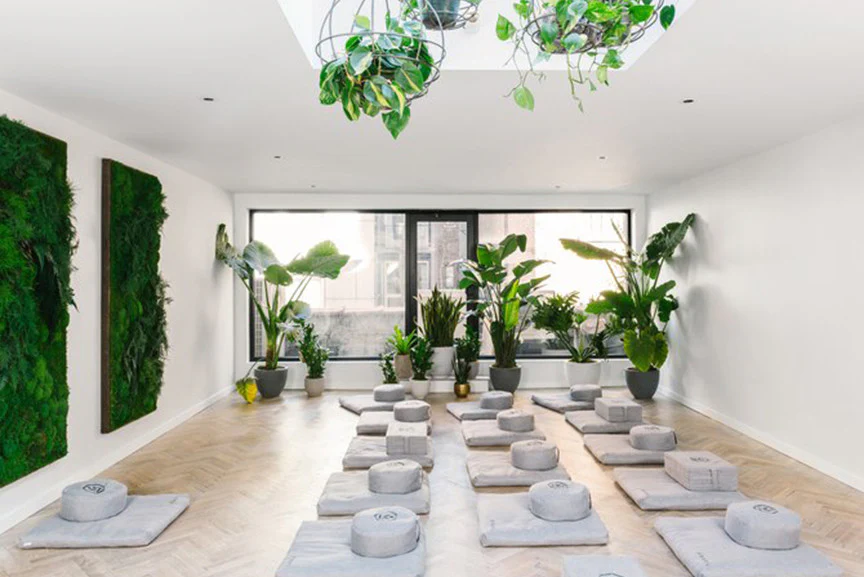
MNDFL in New York City was the first to pioneer bringing the boutique fitness model to mindfulness meditation, rapidly expanding to multiple locations in Manhattan & Brooklyn.
DIGITAL APPS
STRUGGLED WITH RETENTION
Apps like Headspace and Calm excelled in positioning and rebranding mindfulness as an approachable practice without the "woo-woo".
While ultimately they competed with studios to win the same customer dollars, I viewed these apps (and their VC-backed marketing campaigns) as a powerful driver of mainstream awareness that we could capitalize on – growing the overall meditation market for all players.
The apps were the on-ramp to my own personal practice, but I quickly began craving more than their pre-recorded audio files could offer. Indeed, the apps all struggled with long-term retention: many users simply couldn't form a lasting habit. Those that could quickly outgrew their offerings.
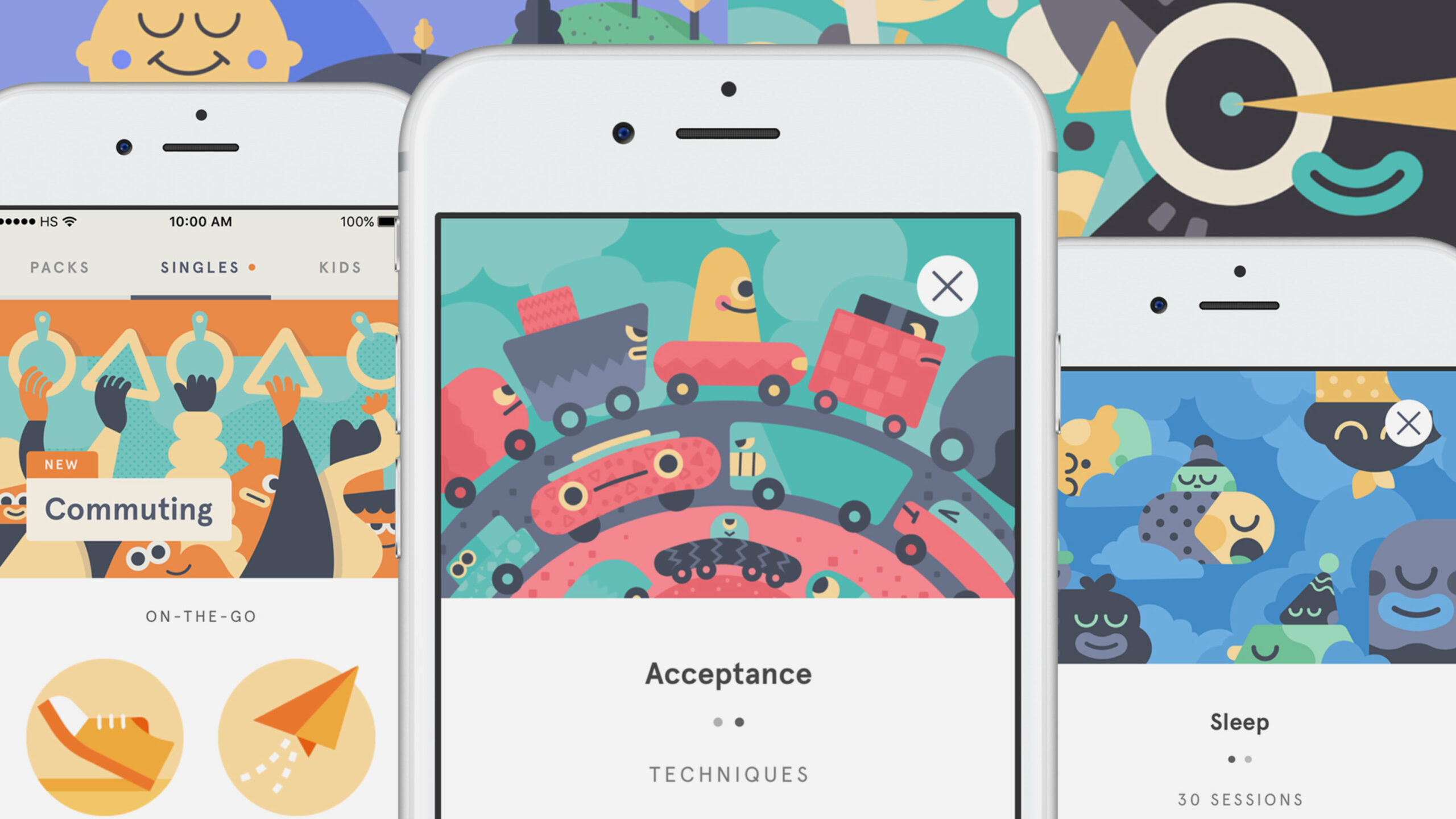
Headspace at the time had raised $75 million from investors, inking mainstream partnerships with companies eager to promote mental health and storming into the cultural conversation.
Understanding the dominant trend of emerging brick-and-mortar players was to all cater towards the same persona, I hoped to carve out a competitive advantage for us in catering to underserved personas.
THE HIGH-INCOME
URBAN PROFESSIONAL
Priority: High
The primary persona I designed for were stressed out urban professionals with an active lifestyle and high disposable income. They are already deeply familiar with the drop-in fitness model, regularly attending classes at Barry's or SoulCycle. They are turned off by "woo-woo" elements like incense and healing crystals – instead feeling more comfortable in modern high-end spaces like luxury spas or private members clubs like Soho House.
While well-paid, their roles are demanding and they experience burnout at far higher levels. These high performers also craved a mental edge: enhancing their focus in an increasingly distracted world
THE SELF-IMPROVEMENT
JUNKIE / BIOHACKER
Priority: Medium
While not a psychographic we targeted initially, it quickly became clear this was a second persona that was also underserved by existing offerings. Biohackers (the somewhat more masculine counterpart to the Goop crowd).
THE URBAN HIPPIE
Priority: Low
This persona tends to skew highly spiritual, into Goop,
Understanding the dominant trend of emerging brick-and-mortar players was to all cater towards the same persona, I hoped to carve out a competitive advantage for us in catering to underserved personas.
1. DISCOVERING MEDITATION
It was almost impossible to have not heard of meditation in 2018. In the face of rapidly declining societal mental health, the practice had taken hold of the cultural conversation in media and corporate initiatives.
2. TRYING MEDITATION
3. LEARNING MEDITATION
4. MAINTAINING MEDITATION
This group constituted the majority of our existing user base but was churning at a high rate because their needs had evolved, while our product had not. Given we had a customer list in the hundreds of thousands, updating the digital product to meet this persona’s new preferences presented the highest potential return with the lowest acquisition cost.
We secured a 2500 sq. ft. flagship retail lease in Toronto's Yorkville neighborhood for our pilot studio. Given the area's high residential density of upscale professionals, as well as a nearby office & transit hub at Yonge & Bloor, this location offered one of the best opportunities to test product-market fit with our target demographic.
We secured a 2500 sq. ft. flagship retail lease in Toronto's Yorkville neighborhood for our pilot studio. Given the area's high residential density of upscale professionals, as well as a nearby office & transit hub at Yonge & Bloor, this location offered one of the best opportunities to test product-market fit with our target demographic.
The studio comprised of two distinct types of spaces: the reception and waiting area, as well as the meditation room itself. As a luxury concept, I wanted to ensure ample square footage towards the former
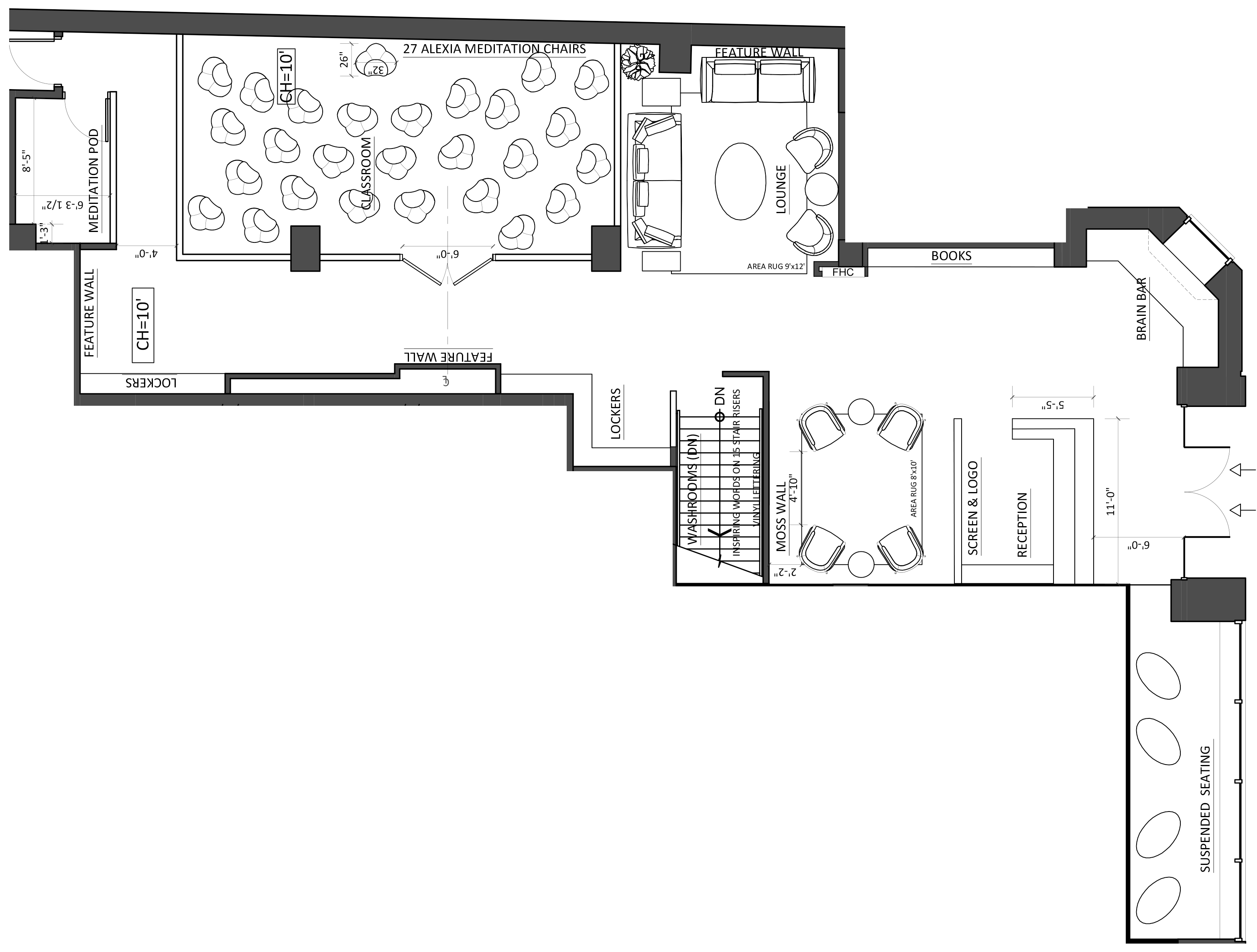
LIVING SPACES
Collaborating with local award-winning interior designer Ariel Muller, I wanted to make the reception and waiting areas feel like a home away from home where clients could unwind. Spa Inc. Magazine wrote, "stepping into this extraordinary space, the noise and frenetic pace of downtown Toronto simply falls away."
Unlike traditional boutique fitness concepts that had people rush in and out of classes, we encouraged clients to maximize these spaces by arriving early and staying late to unwind and enjoy the amenities.
We embraced a neutral & warm color palette and incorporated natural elements like wood, woven straw, preserved moss, and a variety of plants & succulents. A playlist of soft lo-fi beats and cool jazz vibes were piped throughout the space to perpetuate this sense of calm, while a custom neon sign was framed above a couch to maximize viral Instagram opportunities (before/after stowing your phone in a charging locker during class).
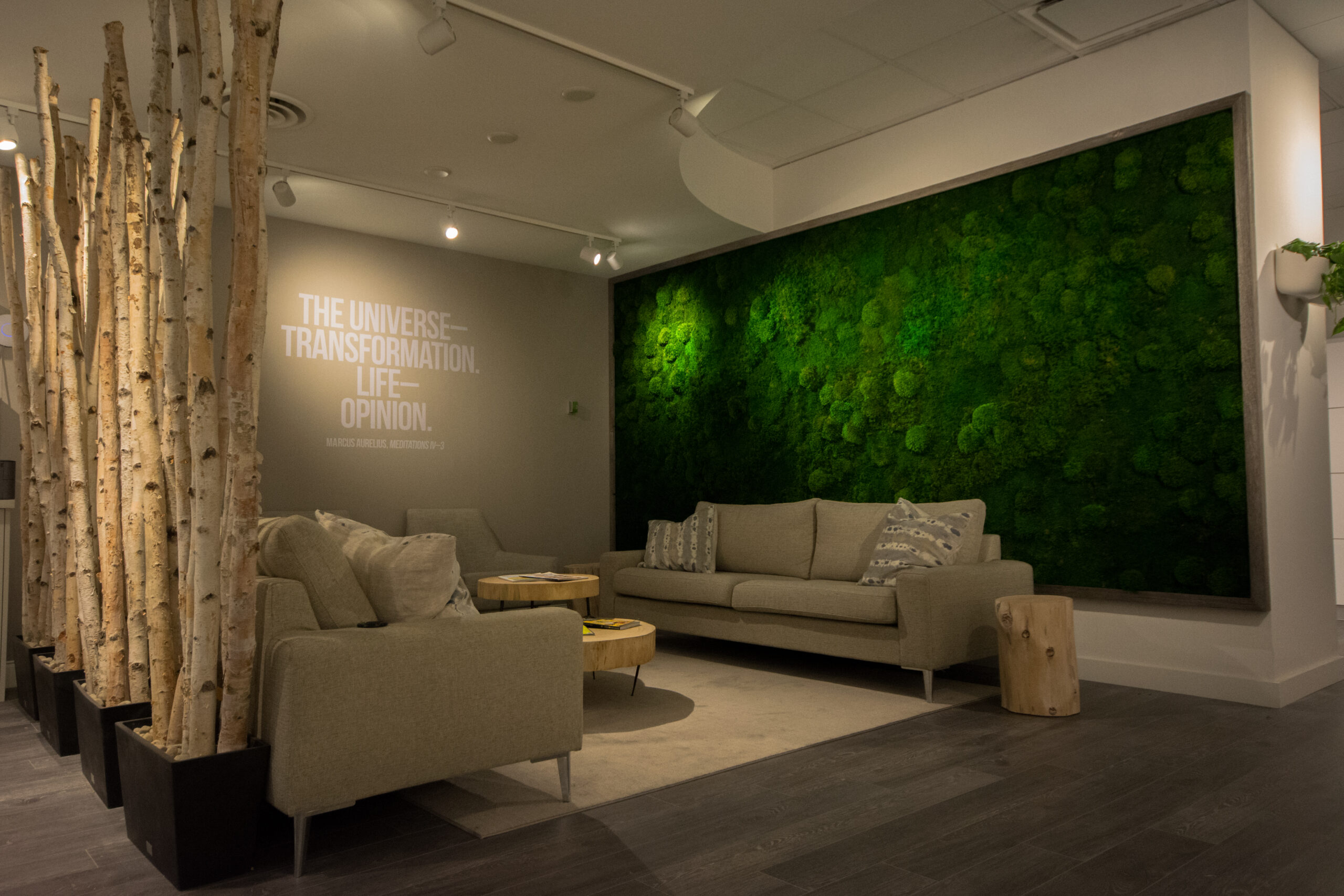
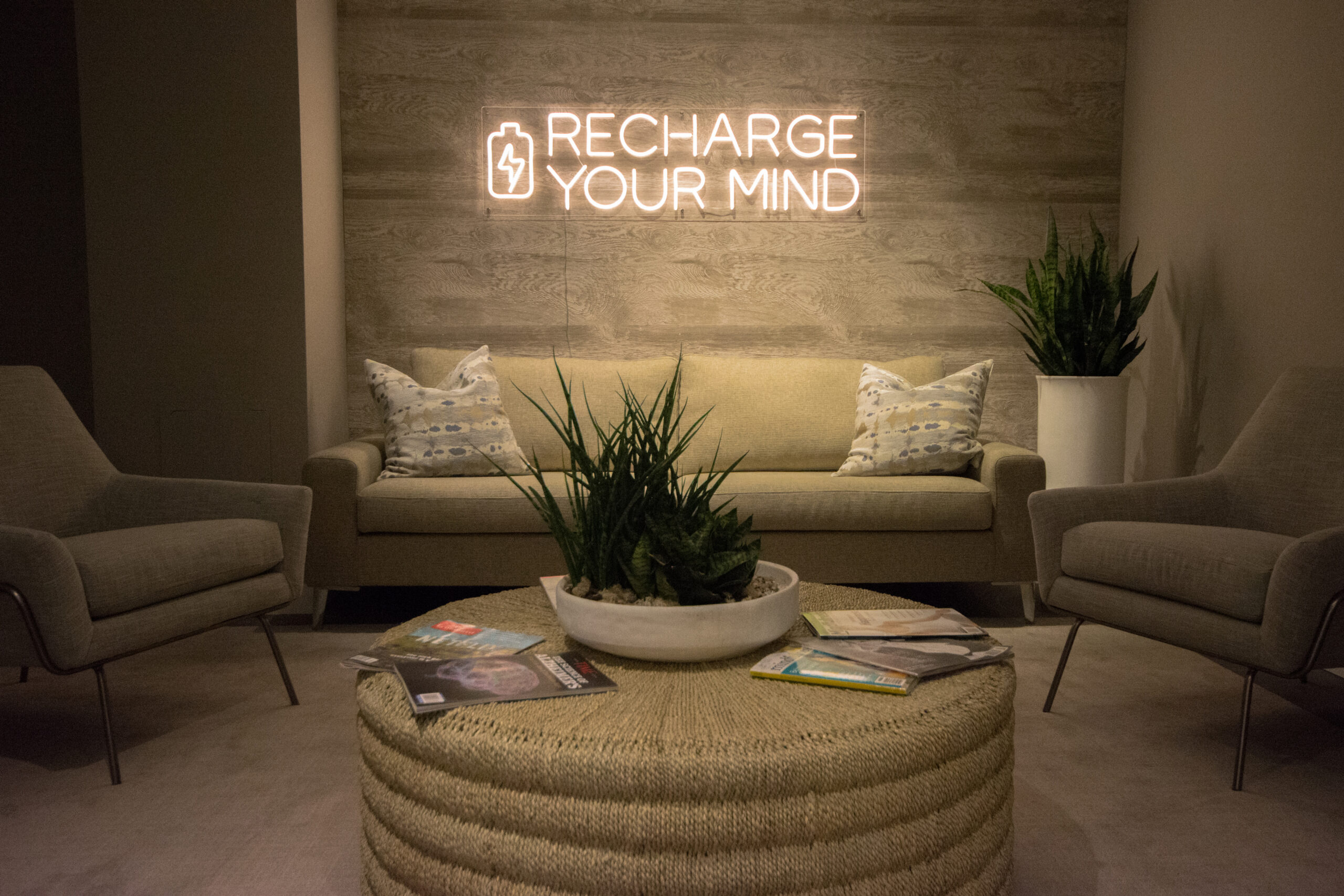
LIBRARY
For retail, I wanted to ensure we avoided "Goop"-adjacent merchandising that could detract from the brand's legitimacy amongst our target demographic – focusing instead on a curated personal development library & bookstore. Clients could grab a book before class to peruse our continuously-updated collection.
Books were showcased with their covers facing out and clearly visible from the street. While not a significant revenue center, familiar titles would serve to attract curious foot traffic from those already interested in self-improvement – serving as a magnet for our targeted personas, and leveraging a downtown flagship address.

BRAIN BAR
At the front, we also made room for a "Brain Bar" that would offer complimentary tea (a custom blend we formulated with a local business to promote focus & relaxation) and kombucha-on-tap (a premium amenity for members, designed to encourage membership upsells).
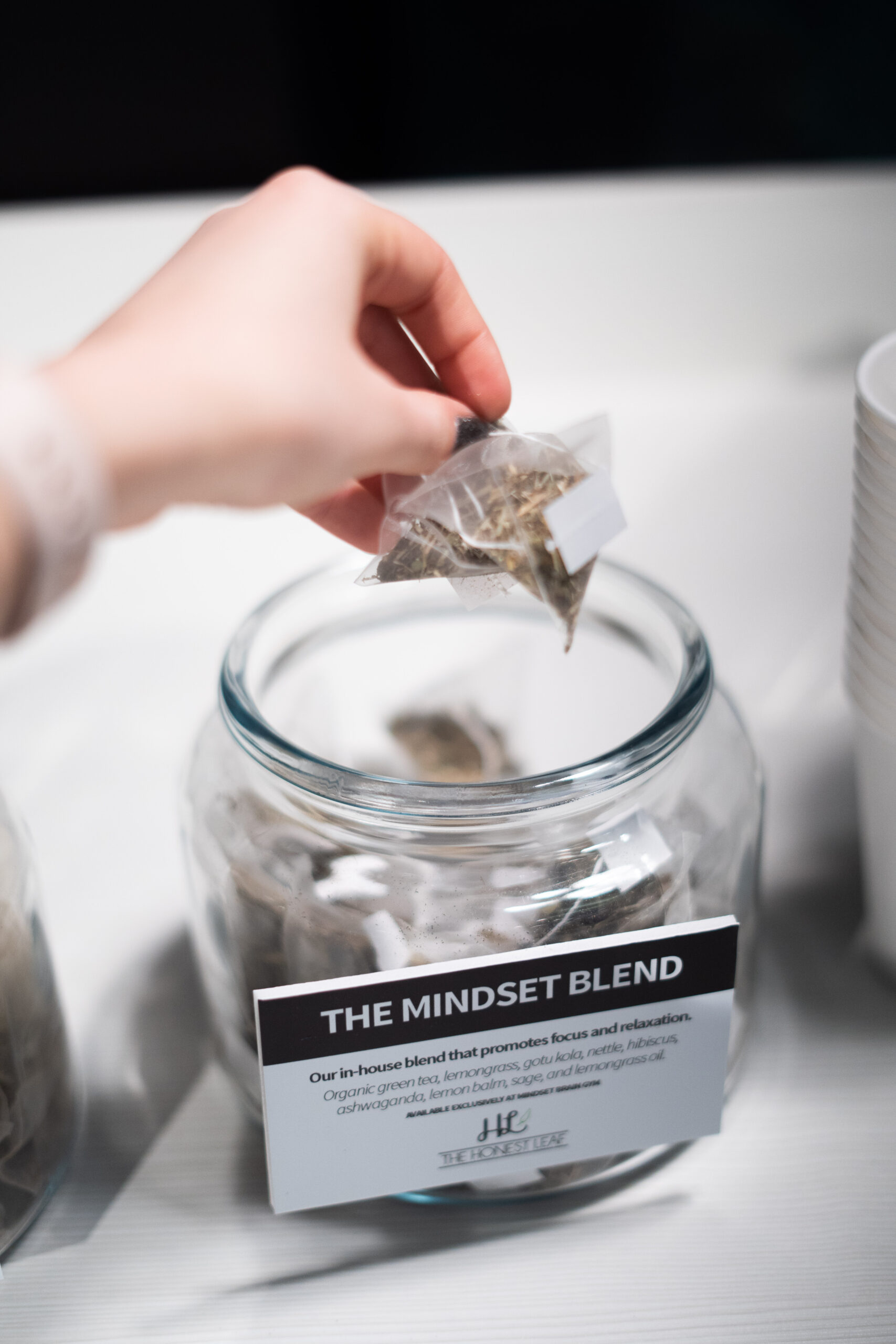
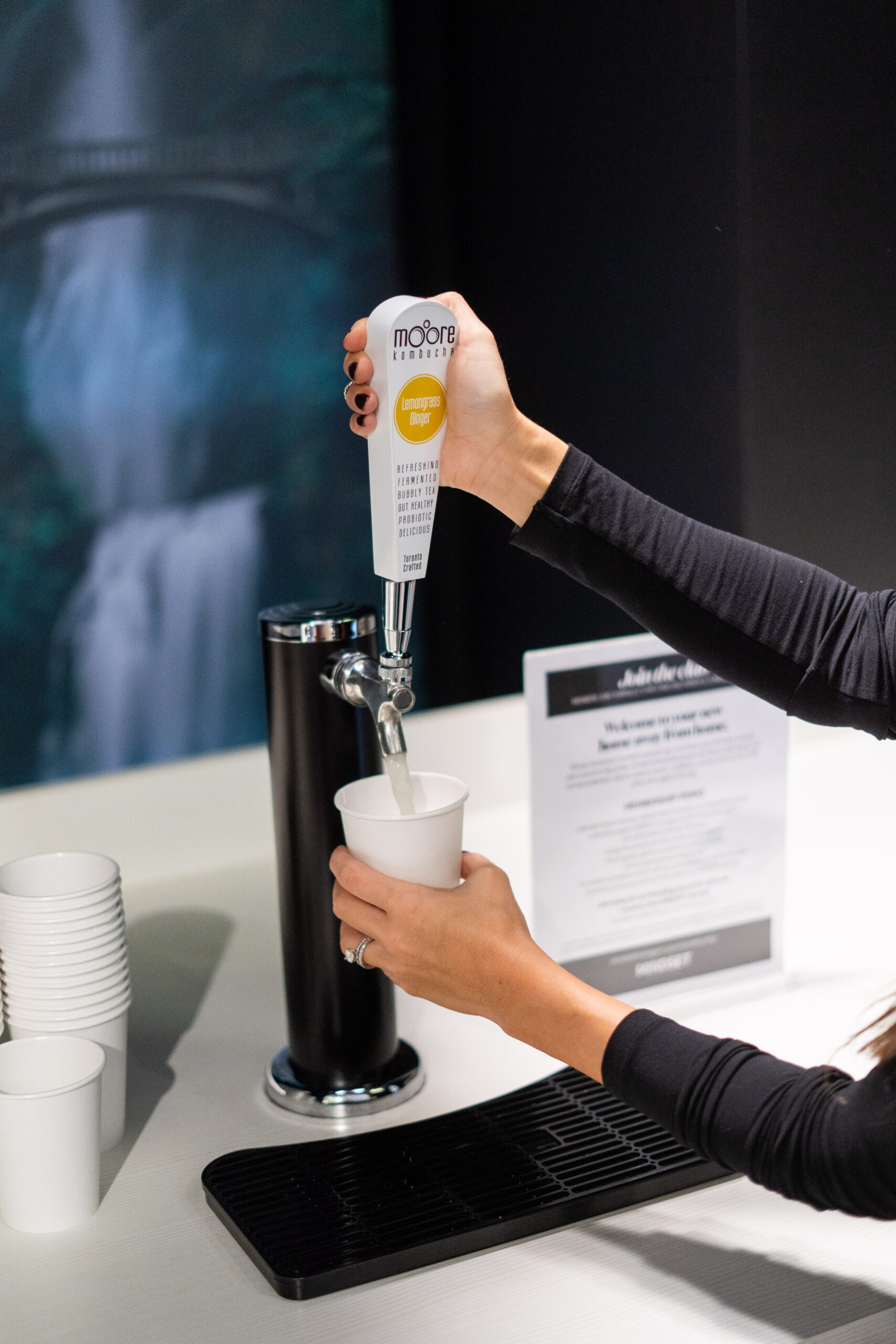
MEDITATION ROOM
In stark contrast to the natural and grounded living spaces outside, I wanted to make the meditation room itself feel modern, ethereal, and technologically-advanced. To host a meditation product that provided substantial added value over the apps, we had to offer an immersive multi-sensory experience.
We deployed the largest-ever commercial installation of Nanoleaf light panels, which washed the room in soothing waves of blue that dynamically matched curated musical journeys.
I commissioned an essential oil expert to develop a signature scent: a citrusy & woody blend. Diffusing this unique scent throughout the class helped clients relax, ground themselves in the present, and focus on their breath.
Lastly, the room featured ergonomic, vegan leather meditation seats that offered exceptional support for seated classes and could be quickly swapped with mats for breathwork offerings.
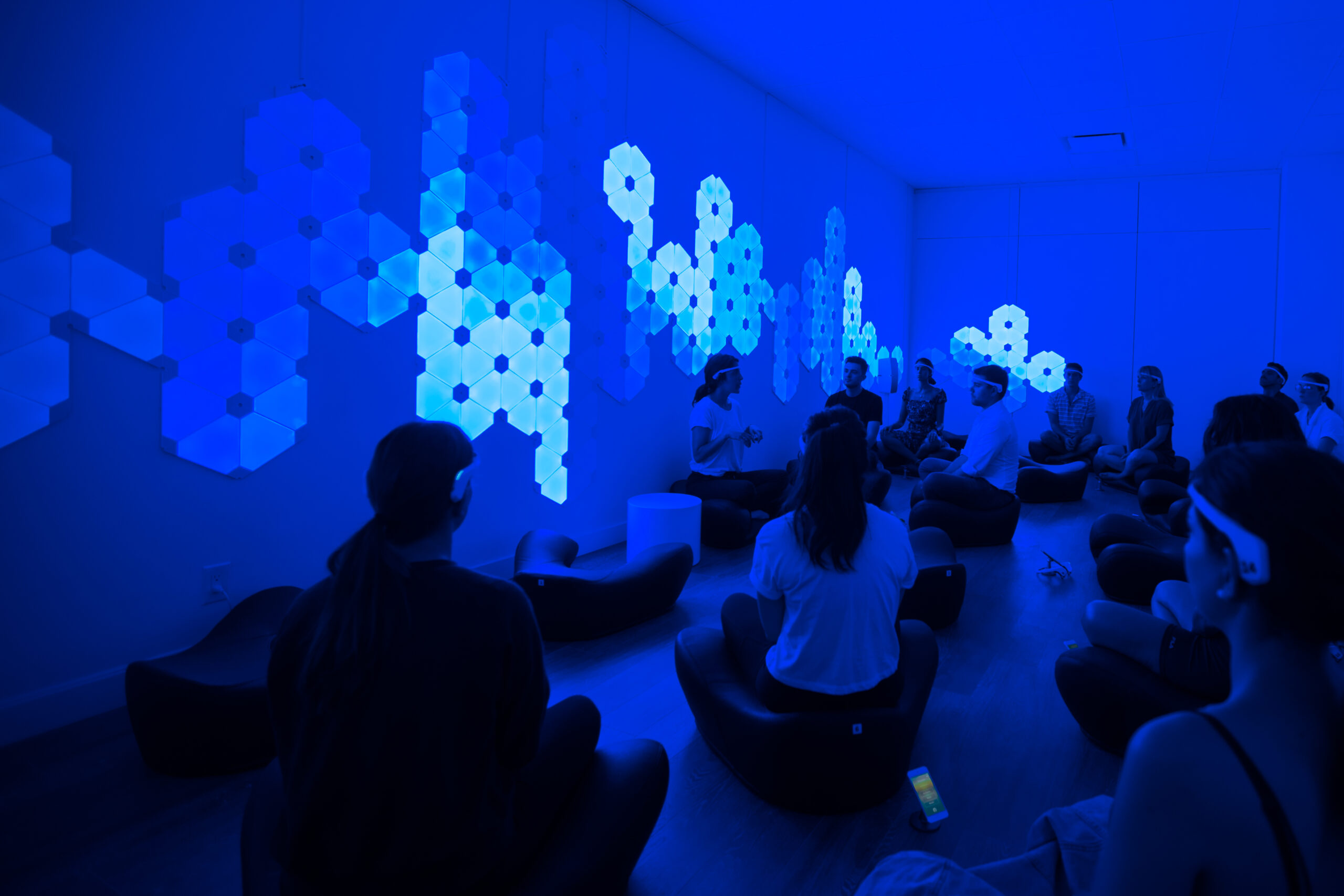
The meditation studio in action, featuring premium ergonomic Alexia meditation seats.
INITIAL PRODUCT
DEVELOPMENT
The studio would primarily be programmed with drop-in classes that ranged from 30 to 45 minutes, utilizing an intuitive naming convention that conveyed the benefit that each style developed through consistent practice.
When hiring teachers, I focused on vetting candidates against three pillars: approachability, authenticity, and deep knowledge of the extensive academic research that validated the practice. This ensured our teachers could effortlessly relate to the average type-A urban professional and address their inherent skepticism with a resonant, science-backed approach.
I also forged an exclusive partnership with Muse—who developed brain sensing EEG headbands—to unlock a unique offering: our signature "Focus" class. This class provided clients the tangibility of measuring how often their mind wandered during the class, and allowed them to track their progress in strengthening their attention over time.
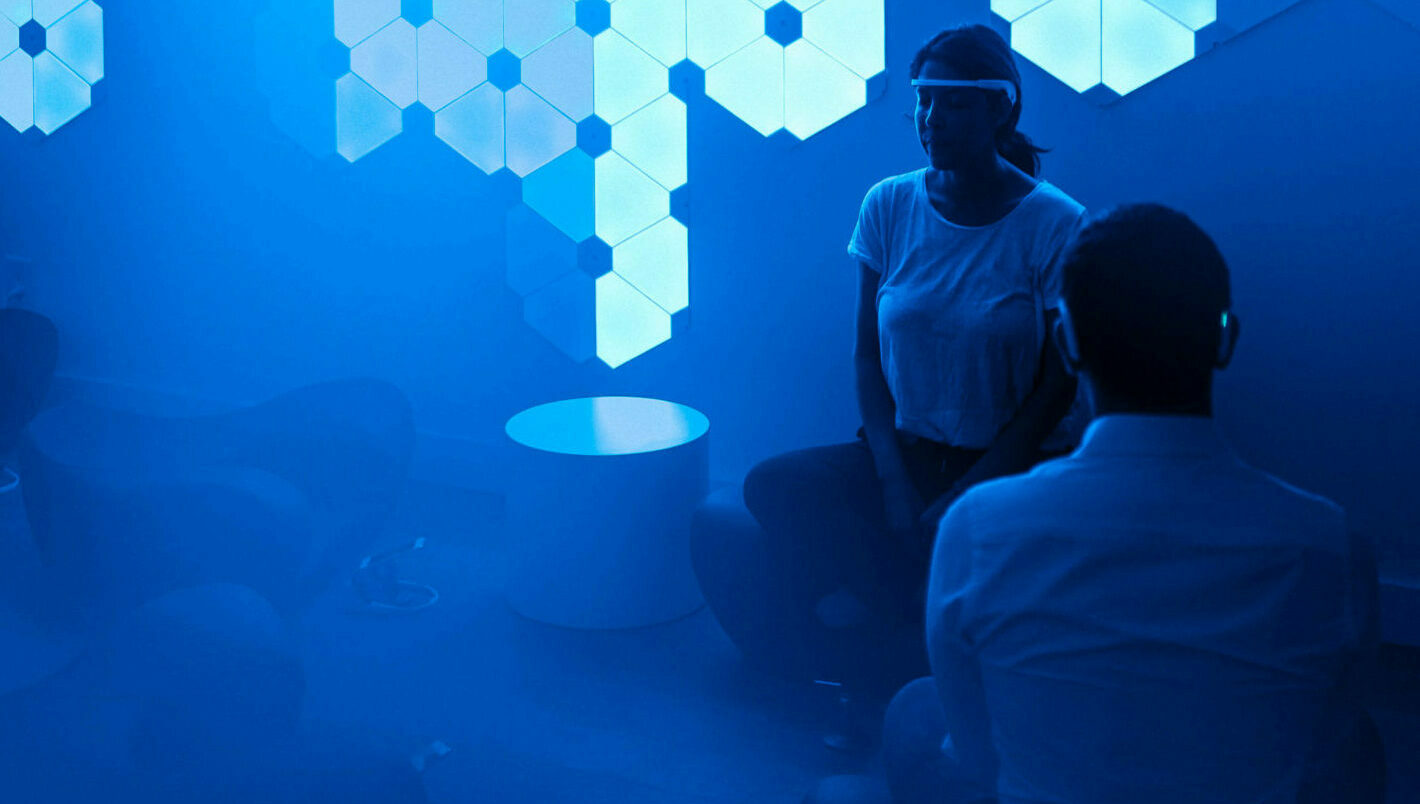
We also sought to test a variety of other classes (without headbands) that employed periphery meditation styles, including:
- Human (loving-kindness)
- Self-Love (mindful self-compassion)
- Creativity (open monitoring)
- Stress Melt (mindfulness)
- Sleep (yoga nidra)
- Momentum (visualization)
Collaborating with leading mindfulness experts in the city, we designed facilitation frameworks for each class type so we could strike the right balance between day-to-day consistency and differentiation.
For pricing, we employed the standard boutique fitness model: classes could be purchased as a one-off, as part of a discounted multi-credit pack, included as part of an unlimited membership, or available via the ClassPass app.
DIAGNOSING
POOR RETENTION
Many were eager to try a class, with high levels of organic client acquisition. Our studio design, and particularly our multi-sensory meditation room, received rave customer reviews.
Despite this, we immediately began to notice clear struggles with long-term retention: a cohort analysis uncovered that we were failing to attract over three visits from 95%+ of new clients. Memberships also did not fare well, with our 2-week trial offer converting in the low single digits.
From the onset, I understood that much of the appeal of traditional fitness classes was experiencing a tangible "sweat factor." This drove my initial decision to offer clear progress metrics, but this was a double-edged sword: while it served as a great press hook and fostered substantial curiosity, clients were discouraged by their initial low scores and often left the studio feeling frustrated, not relaxed.
PIVOTING TO FIND
PRODUCT-MARKET FIT
I sought out to find the true "sweat factor" equivalent for meditation where clients could feel an immediate and undeniable shift in both their physical and mental states. This would address their real pain point: facilitating the release of stress and anxiety-induced tension that builds up the body.
After testing a variety of modalities, I eventually arrived at breathwork. This practice was highly effective at relieving this tension and—in stark contrast to meditation—clients were immediately good at it. Encouraged by early signs of retention, I supplanted all of our mindfulness-based classes with two styles of breathwork set to immersive musical journeys that instructors would curate daily.
The first was an intense, energizing style we positioned as "HIIT meditation" and named Power Breath. The second offered more of an emotional release, and was dubbed Mind Detox. Both proved to be highly popular and sticky: selling out peak time slots, fostering instructor loyalty, and building an engaged community.
We also found success with premium live "sound baths" in the evenings, reinforcing the notion that people would pay a premium for unique experiences that physically alleviated stress, didn't require consistent effort, and couldn't be replicated well in the digital sphere.
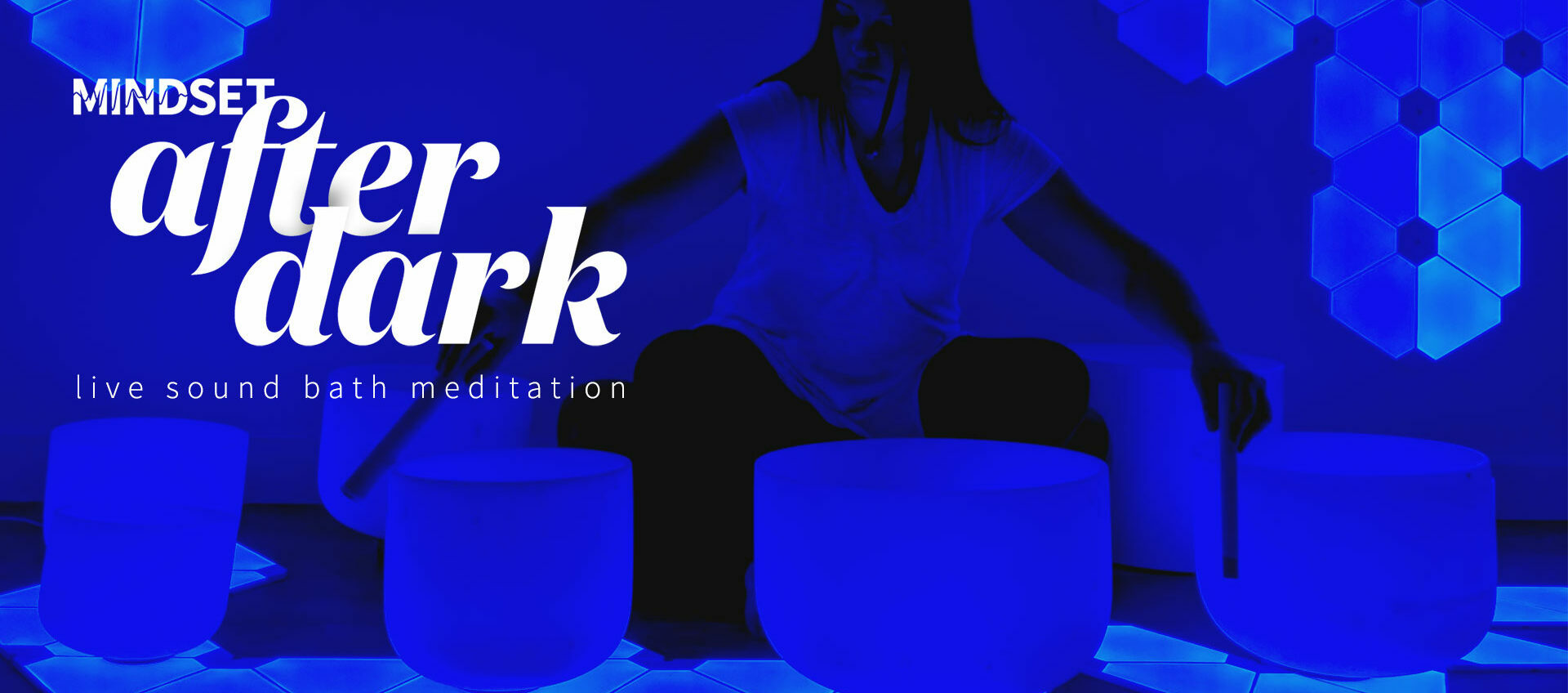
I also began to test a lower-commitment membership that included just 4 classes per month at 40% off the drop-in rate. Paired with our shift in programming, we dramatically increased our trial conversion rate by over 10x.
LAUNCHING MULTI-WEEK COURSES
Despite mindfulness not resonating as a drop-in class, we did tap into substantial product-market fit through offering multi-week, small-group structured courses that blended mindfulness theory with experiential practice.
These courses were higher ticket items and unlocked revenue generation in our living spaces. Further, by including an unlimited membership for the duration of the course, these students became far more connected with the community and were far more likely to convert into a long-term drop-in member than a free trial client.
To maximize demand and revenue for these courses, we hired professional therapists to lead programs like Mental Edge (increasing performance) and Stress Less (increasing resilience). This made them eligible for insurance or HSA/FSA reimbursement as group therapy, and could thus be offered at even higher prices.
For other courses focused on professional training & development, we successfully registered the company as a yoga school with the federal government, unlocking tuition tax breaks.
RECOGNIZING AN
OPPORTUNITY
In an early drive to increase awareness, we initially offered complimentary lunch & learns to nearby offices to promote our drop-in classes with their employees. This effort unearthed a few key findings:
- It was shockingly easy to confirm these sessions, as HR departments were eager to promote mental health & wellness amongst employees.
- Employees were extremely engaged, with consistently high turnout.
- They failed to convert into significant demand for drop-in classes.
Based on the last finding, it would appear that the effort was fruitless (and even discouraging, given that we were presenting to the exact persona we had sought to target with the studio). However, the first two findings gave me pause that we had incidentally stumbled upon an offering with product-market fit.
I immediately began to design a product mix of B2B services that we could sell directly to employers, spinning this off into a section of our website and a corporate sales booklet that we began to pitch to HR departments across the city.
DEVELOPING B2B
Product mix
Our initial foray into corporate sales brought mixed results. Selling employer-sponsored drop-in credits received minimal uptake, and couldn't scale beyond our immediate radius. Studio buy-outs fared better: companies would bring teams for private group classes during weekdays (incremental revenue, as the studio was otherwise closed), however this was a sales-intensive process for one-off revenue.
Ultimately, we found the most success in monetizing and expanding upon our initial lunch & learn sessions, where companies were eager for us to bring our programming to them. We expanded our in-office offerings to include longer executive seminars, regular meditation sessions, and multi-week mindfulness training courses.
Ultimately, we settled on a tailored solution mix that unlocked product-market fit with employers of all sizes, positioning our offerings to fit into four distinct buckets:
Educate: in-office educational sessions
Experience: private studio buy-outs for team building & offsites
Transform: in-office multi-week mindfulness courses
Sustain: in-office recurring meditation sessions
Continuously optimizing our messaging in our B2B marketing materials, I leveraged our strengths as the leading consumer brick-and-mortar studio to build legitimacy with employers. We sponsored conferences for HR leaders and spoke on a variety of industry panels.


RESULTS
By the time the COVID pandemic hit, corporate sales had surpassed consumer revenues. We boasted a client list that included prestigious Toronto-based employers, were enjoying repeat business, and had rapidly developed a reputation amongst HR leaders as a preeminent provider of in-office wellness programming. Unfortunately, due to lockdowns, we became limited to Zoom-based sessions that dramatically limited our revenue potential, and simply weren't enough to sustain the company through lockdowns.

After launch, our overall approach to meditation (e.g. our target demographic, luxury studio in a glitzy neighborhood, and especially brain sensing technology) served as a fantastic press hook that drove over 75 million impressions from earned media placements in prominent Canadian publications, including section covers in the National Post and the Toronto Star, and leading a cover story on wellness destinations in Toronto Life magazine.
